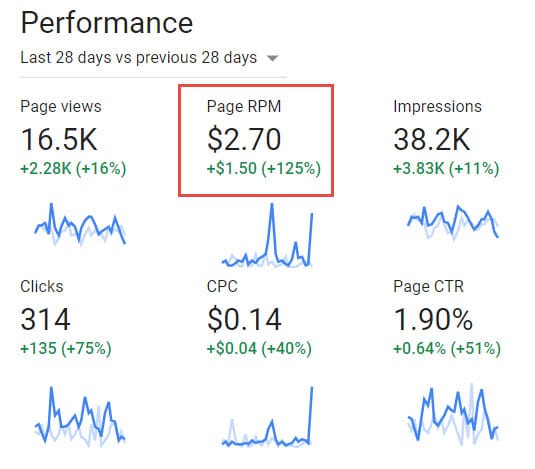When you’re using Google AdSense to monetize your website, one of the most important metrics to track is your page RPM. Page RPM stands for “revenue per thousand impressions,” and it tells you how much revenue you’re earning for every 1,000 ad impressions on your website.
The Importance Of Page RPM When Using Google AdSense
There are a few reasons why page RPM on Google Adsense is so important. First, it gives you a good idea of how well your website is performing from an advertising perspective. If your page RPM is high, it means that you’re attracting a lot of ad impressions and that those impressions are being monetized at a high rate. This is why SEO optimization is a high priority when you are building or maintaining a website or blog.
Second, it can help you compare your website’s performance to other websites in your niche. If your page RPM is lower than the average for your niche, it means that you may need to make some changes to your website to improve your monetization.

How To Improve Your Page RPM
Improving the RPM (Revenue Per Thousand Impressions) of a page can significantly boost your website’s earnings. There are a few things you can do to increase your page RPM. Listed below are some changes that can help increase the RPM:
- Optimize ad placement: Experiment with different ad placements on your page to find the most effective positions. Strategic placement, such as above-the-fold or within content, can enhance visibility and user engagement.
- Improve ad targeting: Refine your ad targeting to ensure that the displayed ads are relevant to your audience. Utilize platforms that provide advanced targeting options, such as Google AdSense or Facebook Audience Network, to reach a more specific audience.
- Increase page load speed: A slow-loading page can negatively impact user experience and ad impressions. Optimize your website by compressing images, minifying CSS and JavaScript files, and utilizing caching techniques to improve page speed.
- Create quality content: Producing high-quality, engaging content attracts more visitors and encourages them to spend more time on your site. This can lead to increased page views and ad impressions, ultimately improving your RPM.
- Use responsive design: Ensure your website is mobile-friendly and responsive across different devices. With the increasing number of mobile users, optimizing for mobile can help increase ad impressions and RPM.
- Implement header bidding: Consider implementing header bidding, an advanced ad optimization technique that allows multiple ad networks to compete for your ad inventory in real time. This can increase competition and potentially improve the value of your ad impressions.
- Evaluate ad networks: Regularly assess the performance of your ad networks. Analyze their fill rates, eCPMs (effective cost per thousand impressions), and overall performance. Adjust your setup to prioritize networks with higher revenue-generating potential.
Finally, the RPM of your page can help you set realistic expectations for your earnings from Google AdSense. If you’re expecting to earn a certain amount of money from AdSense, but your RPM is low, it’s unlikely that you’ll reach your target.
You need to make sure that your website is attracting a lot of visitors. The more visitors you have, the more ad impressions you’ll get, and the higher your page RPM will be. Also, you need to be sure that your ad placements are effective. If your ads are placed in a way that’s annoying or disruptive to your visitors, they’re less likely to click on them, and the RPM of your pages will suffer.
Why Are Ad Placements So Important?
Ad placements play a significant role in the world of advertising. They provide businesses with the opportunity to showcase their products or services to potential customers. Effective ad placements can greatly enhance brand visibility, increase website traffic, and generate higher conversion rates. A well-placed ad can attract the attention of target audiences and effectively communicate the message that businesses want to convey. Thus, understanding the importance of ad placements can help businesses optimize their advertising strategies and achieve greater success in reaching their goals.
Lastly, you need to choose the right ad formats and sizes. Some ad formats and sizes are more effective than others, so it’s important to experiment to find what works best for your website. By following these tips, you can improve the RPM of your page and increase your earnings from Google AdSense.
What Are The Best Performing Ad Sizes And Ad Placements?
Choosing the right ad sizes and placements is crucial for maximizing your advertising impact. It’s essential to consider factors such as the target audience, platform, and industry standards when making these decisions. To ensure optimal performance, here are some tips to keep in mind:
1. Mobile-friendly ad sizes: With the increasing use of mobile devices, it’s essential to prioritize mobile-friendly ad sizes. Common mobile ad sizes include 320×50, 300×250, and 728×90. These sizes are typically responsive and can adapt to different screen sizes.
2. In-feed placements: Placing ads within the content feed on websites or social media platforms can be highly effective. These placements seamlessly integrate with the user experience, increasing the likelihood of engagement. While these ads are great try not to have too many present as they can interrupt the flow of your content. This may increase your bounce rate since the user can easily become distracted.
3. Above-the-fold placements: Placing ads above the fold (the visible area without scrolling) ensures maximum exposure and visibility. This placement is particularly effective for capturing users’ attention as soon as they land on a webpage. This is one of the most effective ad placements. It’s usually the first thing they see on the page before scrolling through your content. By doing so you will increase your impressions from one view to two if an in-content ad is also placed.
4. Native advertising: Native ads mimicking the form and function of the platform where they appear can enhance user engagement. They blend in with the content, making them less intrusive and more likely to be clicked on. For example, if you host a cosmetics webpage or blog, an ad for makeup and skincare may appear. Since the viewer is likely looking for something about these items, this ad will be more likely to receive some form of engagement.
5. Video ad placements: Video ads have gained significant popularity due to their engaging nature. Placing video ads before, during, or after online video content can be impactful for brand awareness and message delivery.
Remember, selecting the best-performing ad sizes and placements may require testing and optimization. Evaluating performance metrics and making data-driven decisions will help you refine your advertising strategy for optimal results.

Here are some additional tips:
- Focus on creating high-quality content that will attract and engage visitors.
- Use relevant keywords in your content and titles to attract visitors who are interested in the topics you cover.
- Optimize your website for speed and performance.
- Use ad blockers to test how your ads are displayed and to see if they are causing any problems for your visitors.
- Track your RPMs regularly and make adjustments as needed.
Remember, every website is unique, and what works for others might not work for you. It’s essential to monitor your RPM closely, experiment with different strategies, and continuously optimize your website to achieve the best results. By following these tips, you can improve your page RPM and increase your earnings from Google Adsense.

